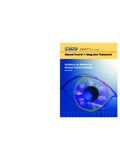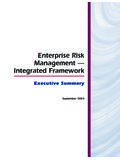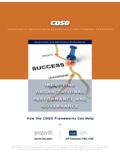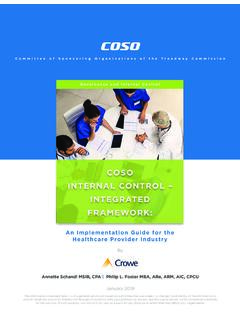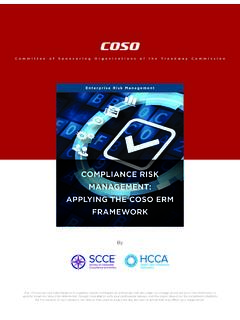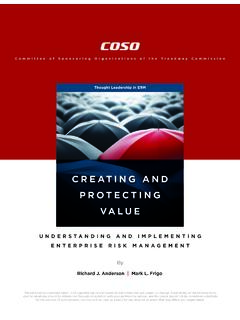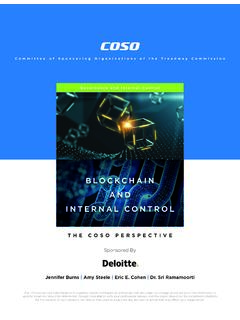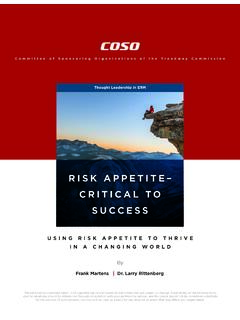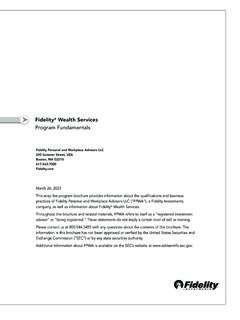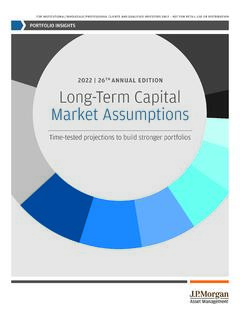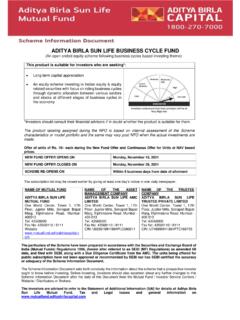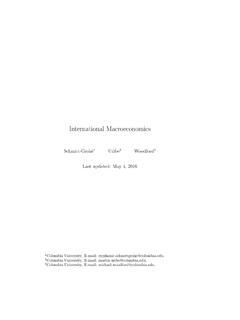Transcription of E nE R T p R i S E R i S k M A n A g E M E n T
1 Thought Leadership in ERM | Enterprise Risk Management Understanding and Communicating Risk Appetite | Larry Rittenberg and Frank MartensCommittee of Sponsoring Organizations of the Treadway CommissionThought Leadership in ERMU nderstanding andCommunicating Risk AppetiteEnTERpRiSE RiSkMAnAgEMEnT2 | Enterprise Risk Management Understanding and Communicating Risk Appetite | Thought Leadership in Larry Rittenberg Ernst & Young Professor of AccountingUniversity of Wisconsin-Madison School of Business Frank MartensDirector, PricewaterhouseCoopers (PwC) This project was commissioned by COSO, which is dedicated to providing thought leadership through the development of comprehensive frameworks and guidance on enterprise risk management, internal control, and fraud deterrence designed to improve organizational performance and governance and to reduce the extent of fraud in organizations. COSO is a private sector initiative, jointly sponsored and funded by the following organizations: American Accounting Association (AAA) American institute of CpAs (AICPA) Financial Executives international (FEI) The institute of Management Accountants (IMA) The institute of internal Auditors (IIA)COSO Board MembersDavid L.
2 LandsittelCOSO ChairLarry E. RittenbergCOSO Chair - EmeritusCommittee of Sponsoring Organizationsof the Treadway F. ChambersThe Institute of Internal Auditors Mark S. Beasley/Douglas F. prawittAmerican Accounting AssociationChuck E. LandesAmerican Institute of CPAs (AICPA)Marie n. HolleinFinancial Executives InternationalJeff C. ThomsonInstitute of Management AccountantsThought Leadership in ERMC ommittee of Sponsoring Organizations of the Treadway CommissionJanuary 2012 Research Commissioned byUnderstanding andCommunicating Risk AppetiteEnTERpRiSERiSkMAnAgEMEnTCopyrigh t 2012, The Committee of Sponsoring Organizations of the Treadway Commission (COSO).1 2 3 4 5 6 7 8 9 0 PIP 198765432 All Rights Reserved. No part of this publication may be reproduced, redistributed, transmitted or displayed in any form or by any means without written permission. For information regarding licensing and reprint permissions please contact the American Institute of Certified Public Accountants, licensing and permissions agent for COSO copyrighted all inquiries to or to AICPA, Attn: Manager, Rights and Permissions, 220 Leigh Farm Rd.
3 , Durham, NC 27707. Telephone inquiries may be directed to Leadership in ERM | Enterprise Risk Management Understanding and Communicating Risk Appetite | iiiExecutive Summary 1 Overview 3 Risk Appetite Statements 6 Risk Appetite and Risk Tolerance 11 Developing Risk Appetite 15 Communicating Risk Appetite 18 Monitoring and Updating Risk Appetite 20 Roles 21 Summary of Considerations 23 About COSO 24 About the Authors 24 Content Outline Leadership in ERM | Enterprise Risk Management Understanding and Communicating Risk Appetite | 1 Executive SummaryOrganizations encounter risk every day as they pursue theirobjectives. In conducting appropriate oversight, managementand the board must deal with a fundamental question: How much risk is acceptable in pursuing these objectives? Added to this, regulators and other oversight bodies are calling for better descriptions of organizations risk management processes, including oversight by the thought leadership document is one of a series of papers, sponsored by the Committee of Sponsoring Organizations of the Treadway Commission (COSO), to help organizations implement enterprise risk management (ERM).
4 The COSO document Enterprise Risk Management Integrated Framework explicitly states that organizations must embrace risk in pursuing their goals. The key is to understand how much risk they are willing to accept. Further, how should an organization decide how much risk it is willing to accept? To what extent should the risks accepted mirror stakeholders objectives and attitudes towards risk? How does an organization ensure that its units are operating within bounds that represent the organization s appetite for specific kinds of risk?These questions are embodied in the notion of an entity s risk appetite. The objective of this paper is to help an organization its senior management, board, and key operating personnel to develop and communicate a clear understanding of its risk appetite, both to determine which objectives to pursue and to manage those objectives within the organization s appetite for organizations view risk appetite as the subject of interesting theoretical discussions about risk and risk management, but do not effectively integrate the concept into their strategic planning or day-to-day decision making.
5 We believe that discussions about applying risk appetite go well beyond theory, and that when properly communicated, risk appetite provides a boundary around the amount of risk an organization might pursue. An organization with an aggressive appetite for risk might set aggressive goals, while an organization that is risk-averse, with a low appetite for risk, might set conservative , when a board considers a strategy, it should determine whether that strategy aligns with the organization s risk appetite. When properly communicated, risk appetite guides management in setting goals and making decisions so that the organization is more likely to achieve its goals and sustain its Risk Management and Decision MakingERM is not isolated from strategy, planning, or day-to-day decision making. Nor is it about compliance. ERM is part of an organization s culture, just as making decisions to attain objectives is part of an organization s fully embed ERM in an organization, decision makers must know how much risk is acceptable as they consider ways of accomplishing objectives, both for their organization and for their individual operations (division, department, etc.)
6 For example, one CEO recently reported that his organization needed to increase its risk appetite amid expectations that key measures of its profitability would fall or stagnate. A financial organization with a lower risk appetite might choose to avoid opportunities that are more risky, but offer greater returns. Finally, another organization with a high risk appetite might decide to procure natural resources from a volatile country where the total investment could be wiped out at the whim of the political leader. The rewards may be high, but so too may the risks. Organizations make decisions like these all the time. Only if they clearly think about their risk appetite can they balance risks and organization must consider its risk appetite at the same time it decides which goals or operational tactics to pursue. To determine risk appetite, management, with board review and concurrence, should take three steps: 1. Develop risk appetite 2. Communicate risk appetite 3. Monitor and update risk appetiteThese three steps are discussed briefly below, and in detail in the body of this appetite is the amount of risk, on a broad level, an organization is willing to accept in pursuit of value.
7 Each organization pursues various objectives to add value and should broadly understand the risk it is willing to undertake in doing | Enterprise Risk Management Understanding and Communicating Risk Appetite | Thought Leadership in ERMD evelop Risk AppetiteDeveloping risk appetite does not mean the organization shuns risk as part of its strategic initiatives. Quite the opposite. Just as organizations set different objectives, they will develop different risk appetites. There is no standard or universal risk appetite statement that applies to all organizations, nor is there a right risk appetite. Rather, management and the board must make choices in setting risk appetite, understanding the trade-offs involved in having higher or lower risk Risk AppetiteSeveral common approaches are used to communicate risk appetite. The first is to create an overall risk appetite statement that is broad enough yet descriptive enough for organizational units to manage their risks consistently within it.
8 The second is to communicate risk appetite for each major class of organizational objectives. The third is to communicate risk appetite for different categories of and Update Risk AppetiteOnce risk appetite is communicated, management, with board support, needs to revisit and reinforce it. Risk appetite cannot be set once and then left alone. Rather, it should be reviewed in relation to how the organization operates, especially if the entity s business model changes. Management should monitor activities for consistency with risk appetite through a combination of ongoing monitoring and separate evaluations. Internal auditing can support management in this monitoring. In addition, organizations, when monitoring risk appetite, should focus on creating a culture that is risk-aware and that has organizational goals consistent with the board it Be Done?This is a common question. Its tone implies two things: (1) articulating risk appetite is too difficult, and (2) risk is considered when management sets strategies, and to further communicate risk appetite is an exercise that simply adds overhead and does not contribute to organizational world events involving governments, businesses, not-for-profit organizations, and the recent financial crisis clearly show that having a communicated risk appetite built into organizational activities could have preserved a considerable amount of capital.
9 We all know the costs of failing to manage risk. Examples include the cost to companies and travellers when air travel closed down after a volcanic eruption in 2010 in Iceland; the cost of the financial crisis to taxpayers, stockholders, and debtholders; and the social cost of government budgets in Greece, Spain, Ireland, and organizations are still tied to the old-school thinking that it will not happen here. The easy rebuttal is that it has happened somewhere, so all organizations should work to manage their risks within their risk appetite. Rather than asking Can it be done? let s say Let s get it done. Determining risk appetite is an element of good governance that managements and boards owe to Leadership in ERM | Enterprise Risk Management Understanding and Communicating Risk Appetite | 3 Overview1 COSO, Enterprise Risk Management Integrated Framework, p. Appetite is an integralpart of Enterprise Risk ManagementCOSO s Enterprise Risk Management Integrated Framework defines risk appetite as follows:The amount of risk, on a broad level, an entity is willing to accept in pursuit of value.
10 It reflects the entity s risk management philosophy, and in turn influences the entity s culture and operating style.. Risk appetite guides resource allocation .. Risk appetite [assists the organization] in aligning the organization, people, and processes in [designing the] infrastructure necessary to effectively respond to and monitor definition raises some important points. Risk appetite is strategic and is related to the pursuit of organizational objectives; forms an integral part of corporate governance; guides the allocation of resources; guides an organization s infrastructure, supporting its activities related to recognizing, assessing, responding to, and monitoring risks in pursuit of organizational objectives; influences the organization s attitudes towards risk; is multi-dimensional, including when applied to the pursuit of value in the short term and the longer term of the strategic planning cycle; and requires effective monitoring of the risk itself and of the organization s continuing risk an organization decides on its objectives and its approach to achieving strategic goals, it should consider the risks involved, and its appetite for such risks, as a basis for making those important decisions.
